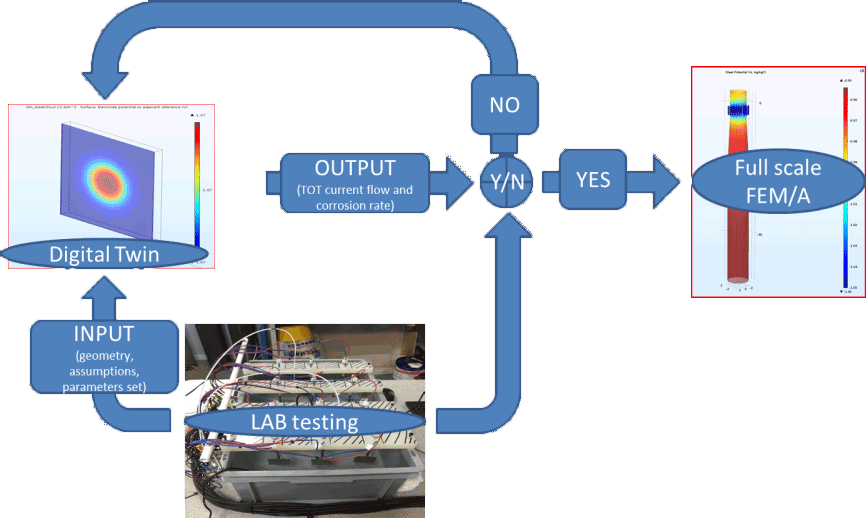Offshore wind design
Lifecycle – a numerical model for TSA lab corrosion testing
In the harsh offshore environment, coating bare steel with thermally-sprayed aluminium (TSA) is now a well-tried and proven form of corrosion protection. While no system is ever perfect, we are working hard in a major strategic partnership to understand, model and predict the electrodynamics of the TSA around holidays to control and limit the corrosion process when damage occurs.
( Text content written by Twenty6 for Diego Cocco, LIC Energy )
When faults do occur, their impact can be extensive and expensive. Although TSA is a highly-successful technology, the fact is that handling induced damage, simple breaks, and even hard-to-detect imperfections, can rapidly compromise the integrity of large, hard-to-reach, load-bearing steel structures in the remote deep metocean environments where the offshore wind industry now operates
Another priority is to be able to calculate how much cathodic protection damaged TSA coatings can continue to give to primary steel exposed to salt water.
This is why at LICenergy (LIC) we are working closely with The Welding Institute (TWI) to develop mathematical modelling techniques that replicate laboratory testing results precisely.
Merging the theoretical and practical
The TWI-LIC project is part of a larger collaboration between eight consortium partners known as the CROWN project which aims to qualify the use of the thermally sprayed aluminium compounds for offshore wind applications – from manufacturing, through laboratory and offshore testing, to numerical modelling.
The TWI-LIC sub project has two parts.
The Welding Institute is running laboratory testing on the corrosion behaviour and corrosion rate of steel samples that include holidays. The holiday is designed to mimic a sub-sea area of monopile foundation where the TSA coating has been damaged and removed to expose bare metal.
In parallel, LIC is developing a numerical model that can be scaled-up to any size. Our aim is to create a set of calibrated parameters that can then be used to predict the through life performance of TSA compounds, and so help maximise the corrosion protection efficiency on real structures. While many parameters are involved in actual offshore corrosion events, LIC’s goal is to produce meaningful results with as few parameters as possible to avoid unnecessary complexity.
Conclusions so far
To date, the results are encouraging
Rather than overcomplicating the model with detailed descriptions of both anodic (at the TSA) and cathodic (at the steel surface) reactions, we have been able to use preliminary laboratory and field data to show that: –
- The area of bare steel is always small when compared to the TSA area. The implication is that the TSA-to-bare steel ratio is favourable to the TSA and the steel is always polarised successfully by the TSA to the full extent of the TSA potential. The conclusion must be that a fully-coated structure is always polarised effectively. With this proved, the development focus can be switched to the current flow on the TSA coating. This is directly proportional to the corrosion rate of the TSA layer
- We have also found that the current flow on the steel surface is limited by the rate of the oxygen reaction on the steel surface. As our work progresses, we will be looking for a way to link our model to the deposition of aluminium, aluminium oxide and calcareous deposits that we expect to see in laboratory testing
- Our third observation is that TSA chemistry can be predicted well by the semi-logarithmic Tafel law for electrochemical kinetics because we won’t be moving far from the equilibrium point due to the small bare-steel to TSA ratio
- As a final step at this point, we have been able to calibrate parameters, such as the oxygen reaction rate and Tafel coefficient, until they matched exactly the total current flow from lab testing The next stage of model development, when more laboratory data and observations are available, will be to capture the more interesting and anticipated dynamics of ‘species deposition’, ‘TSA deposition’ and ‘effect at the TSA-steel interface’.
TSA as a technology
Thermal spraying is a coating process whereby molten or heated materials, including metals and alloys, are applied as micrometre-sized particles in various thicknesses over large areas at much higher deposition rates than coating processes such as electroplating or vapour deposition. As such, they are well-suited to large-scale engineering projects in aggressive environments.
TSA generally offers the toughness, low-maintenance and long component lifetimes that the offshore industry needs to measure in decades.
TWI was founded in 1946 and since 2015 has been based in Cambridge, with five other UK sites. It is one of the world’s leading independent research and technology organisations specialising in materials joining and engineering processes in industry. Other TWI priorities include knowledge transfer, problem-solving, plus whole-life integrity management. The Welding Institute alone has 6,000 members. As part of our own research mission, LIC, which is a member of the strategic CROWN and CROWN2 partnerships, is helping to develop and refine the TS(Z) A (Thermally Sprayed (Zinc or) Aluminium process as a robust coating system that is efficient to apply, very cost-effective and provides long-term steel protection. LIC also specialises in wind turbine monopile design and engineering.
In the CROWN 2 (Cost Reduction for Offshore Wind Now) project, we are working closely with partners that include Orsted (formerly known as DONG Energy), EDF Energy, Scottish Power Renewables, E.ON Climate & Renewables, TWI and Catapult. The aim is to provide industry with the data needed to make informed decisions about corrosion protection options, including the use of TSA.

